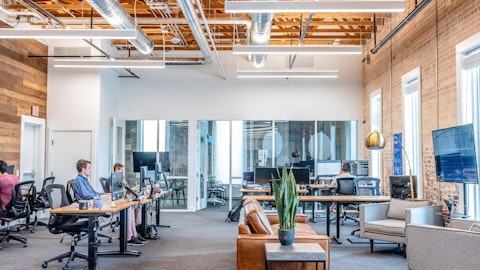CSP Inc. (NASDAQ:CSPI) Q1 2024 Earnings Call Transcript February 14, 2024
CSP Inc. isn’t one of the 30 most popular stocks among hedge funds at the end of the third quarter (see the details here).
Operator: Greetings. Welcome to the CSPi’s First Quarter Fiscal Year 2024 Conference Call. At this time, all participants are in a listen-only mode. A question-and-answer session will follow the formal presentation. [Operator Instructions] Please note this conference is being recorded. I will now turn the conference over to your host, Michael Polyviou. You may begin.
Michael Polyviou: Thank you, Holly. Hello, everyone, and thank you for joining us to review CSPi’s fiscal 2024 first quarter results conference call, which ended December 31, 2023. With me on the call today is Victor Dellovo, CSPi’s Chief Executive Officer, and Gary Levine, CSPi’s Chief Financial Officer. After Victor and Gary conclude their opening remarks, we will then open the call for questions. Statements made by CSPi’s management on today’s call regarding the company’s business that are not historical facts may be forward-looking statements as the term is identified in federal securities laws. The words may, will, expect, believe, anticipate, project, plan, intend, estimate, and continue, as well as similar expressions, are intended to identify forward-looking statements.
Forward-looking statements should not be read as a guarantee of future performance or results. The company cautions you that these statements reflect current expectations about the company’s future performance or events and are subject to several uncertainties, risks and other influences, many of which are beyond the company’s control that may influence the accuracy of the statements and projections upon which the statements are based. Factors that may affect the company’s results include, but are not limited to, the risks and uncertainties discussed in the Risk Factors section of the annual report on Form 10-K and the quarterly reports on Form 10-Q filed with the Securities and Exchange Commission. Forward-looking statements are based on the information available at the time those statements are made and management’s good faith belief as of the time with respect to future events.
All forward-looking statements are qualified in their entirety by this cautionary statement and CSPi undertakes no obligation to publicly revise or update any forward-looking statements, whether as a result of new information, future events or otherwise after the date thereof. With that, I’ll turn it over to Victor Dellovo, Chief Executive Officer. Victor, please go ahead.
Victor Dellovo: Thanks, Michael, and good morning, everyone. Earlier this morning, we announced our fiscal 2024 first quarter results. However, before I ask Gary to review the quarter, I want to spend a few minutes highlighting two developments that were recently announced as I believe these truly demonstrate our growing business prospects and continued optimism with high-performance products in the Technology Solution businesses. To begin, the launch of the AZT PROTECT offering is and continues to be a game-changing development within the high-performance products, or HPP business, because the advancements allow us to offer our customers a giant leap forward in the evolution of cybersecurity solutions. Few days ago, we announced our largest and most significant contract to date for AZT, a multimillion dollar agreement with a global pharmaceutical company deploying AZT across its global manufacturing operation technology, or OT, protecting over 40 facilities in response to the growing cybersecurity threat to OT from hostile nation states, terrorism and organized cybercrime.
This customer appreciates the enormous risk of cybersecurity attacks on the facilities. It could lead to theft of intellectual properties, compromise safety and quality, regulatory fines, and major disruptions to its manufacturing process. However, many other remain extremely vulnerable and are ill-prepared to protect their critical assets from new wave of cybersecurity threats that can bypass network bypass protections in modern cloud-based next-generation antivirus solutions. The second development that was also recently announced was a five year multimillion dollar contract to provide managed services for a prominent Florida public college, one of the largest and most diverse institutions of higher education in the nation. We will deliver proactive monitoring, management, and support for college critical infrastructure including networking, security and private cloud services.
I believe these two developments are a strong indicator of the future success and is precisely why the Board of Directors had the confidence to raise its quarterly dividend to $0.05 per share. I will spend a few moments highlighting the Technology Solutions or the TS business, and then I will focus the majority of my comments on the AZT offering as it has the potential to dramatically change our growth curve. The TS business performed as planned, and we continue to be excited about the current business as well as the leads being generated on a daily basis from new and existing customers. The TS business accounted for $14.7 million of the overall revenue and its success continues to be driven by our customers’ increasing use of our implementation, installation, and training capabilities.
As I stated on the last call, the UCaaS is becoming a profitable business, and we ended the fiscal first quarter with an increase in clients, and based on our current information and leads flow will continue to see an upward swing in the clients’ activity as we move throughout the fiscal 2024. As many of you know, it’s been a challenging business environment for several years and the team’s ability to remain engaged with customers is amazing. I believe the yes, can-do attitude has enhanced our clients’ loyalty because they recognize that our products and solutions are the most effective, cost-efficient answer to their critical needs. For example, while our cruise-related business has been relatively quiet during the following of the pandemic, the team has remained on the ready, and we are beginning to see some positive developments.
For example, we received orders for several ships from one of the cruise line operators and the consistent growth of our non-cruise related shipping business is continuing as we currently are working with one of the largest freight operators specializing in containerized ocean exports serving numerous ports worldwide with an extensive global agent network and has become one of our larger MSP customers. Turning now to our high-performance products, our HPP business, my comments will focus solely on the emerging AZT offering as it continues to generate a significant amount of interest in the market that we believe will grow to over $50 billion based on the number of devices that need to be protected across the relevant verticals. We are excited about the industry’s positive reaction to AZT.

And we will remain bullish. Our sales funnel is getting larger and is attracting prospects across the Fortune 500. As a reminder, AZT’s advancement allows us to offer our customers a giant leap forward in the evolution of cybersecurity solutions. AZT’s performance surpasses what’s available on the market today and its new generation of endpoint cybersecurity protection designed for critical operation technology environments. For example, and based on the internal testing, we believe AZT would have stopped solar wind Sunburst malware used during the attack after the initial breach. The unique tie-in solution protects aligned organization endpoints from a full spectrum of cyberattacks and attack techniques, including the most advanced zero-day attacks, malware, ransomware, supply chain vulnerabilities.
Even those threats that are completely unknown to security teams. By deploying artificial intelligence capabilities, AZT automatically halts attacks before damage occurs, ensuring seamless operations without disruption or downtime. It lowers the risk of applications code-based vulnerabilities from exploit while running on endpoint devices to near zero. This removes the need for constant security patching updates and associated costs of production downtime. On the last call, I mentioned a number of industry events and conferences the team attended. And that each one, our name and reputation is growing, and we are garnering more and more attention. For example, Gary Southwell, CSPi’s General Manager of ARIA Cybersecurity, recently hosted a webinar with retired Pfizer Global Head of Automation Engineering, Jim LaBonty.
They discussed a wide range of challenges manufacturers face in today’s new threat landscape. They delved into issues manufacturers need to address ranging from how to select the right technology to best practice to ensure critical manufacturing operations are protected. They focus on how current passive and active cloud-based security solutions are failing to guide against the new era of AI embedded attacks, creating substantial financial, regulatory, and reputational risk in manufacturing sectors such as pharmaceuticals. The webinar demonstrated how ARIA Cybersecurity’s breakthrough solutions for OT environments would have stopped the solar winds attack and other recent high-profile attacks on critical infrastructure, where existing defenses have failed.
We are planning additional webinars every quarter going forward. Additionally, we have — we will be attending several conferences in the coming months, including the CS4CA manufacturing conference in Houston, and the DistribuTECH International Conference in Orlando. Our current customers are very chemical and natural security pharmaceuticals, demonstrating the breadth of our offering. In fact, there is no limit, no industry we can’t access through our AZT offering given the wide range of needs of companies dealing with constant attacks on their enterprises. Our goal is to ensure the team remains focused and is able to deliver consistent results, which basically means it’s just as important to pursue smaller transactions while still hunting elephants which can take up to several months to close.
Additionally, we have continued to add resellers to leverage their knowledge, expertise, and customer depth to drive greater adoption of ARIA Zero Trust Protect, including the addition this week of a leading cybersecurity of ARIA’s firm and reseller, which serves around 6,000 companies worldwide, including a focus on large enterprises in the world. To summarize, we remain cautiously optimistic and continue to position the company for greater success throughout fiscal 2024. We have two stellar businesses, the TS business, which has been the growth driver over the past few years, and the reemergence of the HPP through AZT offering is generating significant buzz throughout the organization and within the industry. With that, I will now ask Gary to provide a brief overview of the fiscal first quarter financial performance.
Gary?
Gary Levine: Thank you, Victor. For the first quarter ended December 31, 2023, we reported revenue of $15.4 million compared to $18.3 million in the year ago fiscal first quarter. The revenue could have been higher. That is if certain contracts were signed as expected towards the end of Q1. However, there were pushouts to the end of the year in the holiday season and signed contracts were signed earlier this quarter and will benefit fiscal Q2 revenue. Our Q1 gross revenue was $4.1 million or 26.6% of revenue compared to $5.8 million or 31.7% of revenue in the same prior year period. The decrease in gross margin compared to the year ago period as anticipated was due to the mix of business and the lower margin products. We continue to believe our gross margin will expand as the business transitions, especially the AZT offering, to higher-margin products and services.
For the first fiscal quarter, our engineering and development expenses were $700,000, $173,000 lower from the year ago fiscal quarter as we reduced outside contractors and elected to not fill some open positions. Our SG&A costs for the fiscal first quarter was $3.7 million compared to $3.6 million in the year ago fiscal first quarter. The slight year-over — year-over-year increase is attributable to the addition of several salespeople and increased conference participation to help us raise awareness of the AZT offering. We reported a slight net loss of $73,000 or $0.02 per diluted share for the fiscal first quarter ended December 31, 2023 compared to the net income of $1 million or $0.21 per diluted share versus fiscal first quarter ended December 31, 2022.
The company had cash and cash equivalents of $25.6 million as of December 31, 2023, compared to cash and cash equivalents of $25.2 million as of September 30, 2023. We believe our robust financial position allows us to be flexible and successfully implement our operating initiatives, and if necessary, leverage this to finance large customer agreements which have been highly successful in the past for CSPi. As Victor mentioned earlier, the Board of Directors approved an increase in the quarterly dividend to $0.05 per share, payable on March 8, 2024, to shareholders of record on the close of business on February 26, 2024. With that, I will turn it over to the operator to take your questions.
See also 30 Unhappiest Countries In The World and 20 Fastest Growing Technology Companies in the US.
Q&A Session
Follow Csp Inc (NASDAQ:CSPI)
Follow Csp Inc (NASDAQ:CSPI)
Operator: Certainly. [Operator Instructions] Your first question for today is coming from Brett Davidson with Investletter.
Brett Davidson: Good morning.
Victor Dellovo: Good morning, Brett.
Brett Davidson: Must be pretty satisfying to finally land that bigger deal?
Victor Dellovo: Oh, my god.
Brett Davidson: And I’m thinking, too, so as far as salespeople, I know you added some in the past. Has that changed your thinking any? Is there plans to add more along the sales lines or are you guys pretty set right now?
Victor Dellovo: No, we’re interviewing other people right now. So we’ll — we plan on adding to that this quarter in the future.
Brett Davidson: Has it changed like the company’s compensation philosophy? As far as share grants or kind of like tying these people to the prospects of the company overall?
Victor Dellovo: All of that is on the table when we talk to these individuals.
Brett Davidson: Yeah. I mean I’d love to see the people that are working there and selling this thing highly invested in the performance of the company. I think that would be just a great idea. And then a little bit on the revenue recognition of that contract the other day, how is that going to run through the income statement? Is that going to be all at once or is that going to be spread out over time?
Gary Levine: That’s all at once.
Brett Davidson: Okay. So that will drop this coming quarter? Nice. And last time we talked, I know that the cruise business was still kind of slow getting rolling here again. Has that changed at all? Is there any more progress on the cruise ship business?
Victor Dellovo: Yeah. We made some progress on a little different work than we’ve done in the past. I can’t mention what kind of work we’re doing with them, but it’s — we kind of moved into a new technology with the cruise line, and we’re rolling it out to a bunch of ships. We won’t have to travel as much as we used to in the past. We can do it a lot remote. But yes, it gave us a new form of income from these cruise lines that will be coming over the next couple of quarters.
Brett Davidson: And what does the size of that business look like?
Victor Dellovo: It’s in the hundreds of thousands.
Brett Davidson: Got it. And is this applicable to pretty much all the cruise lines or is this just like certain customers that still can take advantage of this?
Victor Dellovo: No, every cruise line could do it, we’re just not talking to every cruise line about it yet. Getting in front of them is half the battle.
Brett Davidson: Yeah. Interesting. And that deal with the pharmaceutical company, I know you guys did not release the name of that. Are you guys able to use the name of that company when you are discussing sales with other potential customers?
Victor Dellovo: With permission, yes.
Brett Davidson: So that is a possibility that you…
Victor Dellovo: We have to ask permission, yes.
Gary Levine: Yeah, they are a referenceable account.
Brett Davidson: What was that, Gary?
Gary Levine: They are a referenceable account, but we do need to get their approval on the accounts.
Brett Davidson: Got it. All right. Well, it was pretty exciting seeing those press releases. I hope to see more of them in rapid succession here.
Victor Dellovo: As soon as — as I said to numerous people numerous times, I don’t hold anything back. Until — I had said earlier, I thought the ink was close to being dry on some of them, but working with these large — working with these large organizations, everything takes way longer than expected. Some of these things needed 10 signatures and getting 10 signatures I guess in a large organization is — it takes months, not weeks.
Brett Davidson: Yeah. Well, it’s nice to have. No matter how confident you are in the product, there’s always that lingering doubt in the back. It’s nice to see that first big contract come through kind of confirming that your headed down the right path. It was…
Victor Dellovo: Yeah. Exactly. Exactly.
Brett Davidson: Yeah. I’m very glad to see that. Glad that finally put behind you the big deal there and looking forward to plenty more. Great job. Bring everybody along with you.
Victor Dellovo: Yeah. We’re trying. We’re trying. Thanks, Brett. Appreciate your support.
Brett Davidson: All right.
Operator: Your next question is coming from Joseph Nerges with Segren Investments.
Joseph Nerges: Good morning, guys. Guys, how are you today?
Victor Dellovo: Good.
Gary Levine: Good morning, Joe.
Joseph Nerges: I just want to tell everybody that the annual meeting was very nice last week, and we had a — from an investor standpoint, we had 100% increase in the attendance. That’s the good news. The bad news, we went from one to two people at the annual meeting. I’ve been to annual meetings where we had a game-changing product and was standing room only. We’re not there yet. But maybe the possibility down the road that we’ll have standing room only at the meeting. A couple of quick things. I researched just briefly on your release of the pharma contract the Merck breach, which was breached a number of years ago. And just to let the market know here, the damages on the Merck breach, the insurance companies paid $1.4 billion.
That’s how much damage was done by that breach with Merck, so just to give you an indication of how much some of these OT environments are at risk when that type of a damage award can be out there. I don’t know how — do you guys know how the insurance is involved with these companies? I mean is there a separate policy for let’s say the OT environment as opposed to the IT environment for breaches or is this kind of all rolled into one? Or do you not know that?
Victor Dellovo: I have no idea, Joe. I have no idea how each…
Joseph Nerges: Yeah. I’m just saying, when you see that kind of — I mean when you hit the OT environment, you could take down factories. I mean for an extended period of time, and so you could see where the costs could be quite dramatic. I don’t know how these insurance companies work, but I imagine they are pressuring these companies to either provide better security or the premiums on the policy — either there will be no policy or the premiums will be sky high on that type of award.
Gary Levine: I can tell you, Joe, that just in our case as a small company, what we had to go just to get our cybersecurity. And in talking to the insurance companies, they’re taking a very hard line on it. And you need tools such as we have to implement to help. Because if you don’t have any protection, you don’t get any insurance. They will give you nothing.
Joseph Nerges: Well — and that’s I guess the point I’m trying to make. And of course, we’re too early with the AZT PROTECT rollout to — in other words, if you could become almost a best in breed for the OT environment, then there would be demand from either the insurance end or to protect yourself to the best you can. I’m just hoping that we can get ourselves known well enough that the companies, even the insurance companies, begin to recognize the benefits of the AZT PROTECT product. We’ll see how that goes down the road. A couple of things at the annual meeting you mentioned. One was your intellectual property. I think you said, Victor, that there was — that we have two patents awarded. And what do we have, six or eight more pending? Is this — I’m trying to recall what you said on that.
Victor Dellovo: Six total. Two that are already approved, two that are in the last waiting stage. I think if my memory serves me right, I think it was supposed to be February, March somewhere. It’s the waiting stage of just making sure no one has any issues. And then two that are in more of the…
Joseph Nerges: Longer term.
Victor Dellovo: Review. The review process.
Joseph Nerges: Okay. And I assume almost all of it is tied to the ARIA platform, right or the…
Victor Dellovo: It’s all the AZT. It’s all six are on it, yep.
Joseph Nerges: Okay. A couple of things. I did ask you two on R&D, what are we doing? And I think you said we’re in beta tests now. We’re expanding the software to Android devices out there. Is that what you’re saying? We’re testing the…
Victor Dellovo: Yeah. It’s on the road map, yep. Android is on the road map.
Joseph Nerges: And I think you were adding to even the screen capability, where multiple screens can be reviewed by some of these managed service providers at one time?
Victor Dellovo: Yeah. It’s on the roadmap. Yeah. It’s on the road. We’re still in the development. [Multiple Speakers]
Joseph Nerges: Yeah. I don’t think a lot of people out there realize that when you introduced AZT PROTECT in July, we weren’t on Version 1. We were on multiple versions, we had gone through multiple versions before we came out with that. It wasn’t like it was the first version that came out there. And since then, of course, you added the Linux, right? I don’t know what version you’re in. Do you know what version we are in now on the AZT PROTECT product? I mean we must be six or seven now.
Victor Dellovo: No, I think we’re on like 13.
Joseph Nerges: Really?
Victor Dellovo: I think, yes.
Joseph Nerges: Say that again. Sometimes when most people come out with a version, it’s 1.0. But we’re not there. We’ve advanced this over the number of years pretty extensively.
Victor Dellovo: Yeah. I think I had mentioned before that our original goal was to get a version out and then add a lot of the functionality and the bells and whistles as we moved along. But through one of our large customers that we’ve talked about, they needed all the functionality immediately before they were willing to sign off on it. And that’s kind of why it took a lot longer for the development and truly the first release that was available to sell was in this past July.



